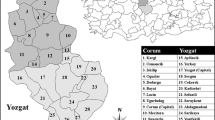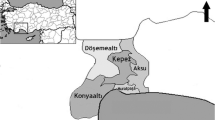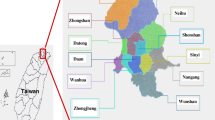Abstract
From January 2010 to December 2011, a total of 138 cases of ticks feeding on humans were reported from 11 locations in central Panama. Five of these locations were situated in forest environments, three in rural landscapes and three in urban areas. The ticks were submitted to the Gorgas Memorial Institute, where nine species were identified among 65 specimens: Amblyomma cajennense s.l., A. dissimile, A. naponense, A. oblongoguttatum, A. ovale, A. sabanerae, A. tapirellum, Haemaphysalis juxtakochi and Rhipicephalus sanguineus s.l. The remaining 73 specimens consisted of unidentified immature ticks, all belonging to the genus of Amblyomma. Rhipicephalus sanguineus s.l. was the species most frequently associated with humans, particularly in urban environments. In rural landscapes, tick bites were most often caused by A. cajennense s.l., whereas A. tapirellum was the species most often found parasitizing humans in forest environments. These data provide information on the tick species most commonly associated with humans in forested environments, rural areas and cities around the Panama Canal.
Similar content being viewed by others
Avoid common mistakes on your manuscript.
Introduction
Ticks are an important group of ectoparasites of cold and hot-blooded vertebrates. Although no species of tick is naturally associated with humans, ticks are among the principal vectors of zoonotic agents (Fairchild et al. 1966), highlighting species those causing Rickettsioses, Erhlichiosis, Lyme disease and Hemorrhagic Fevers (Telford and Goethert 2008; Williamson et al. 2010). In addition, tick bites may cause irritation, allergic reactions or even paralysis, underlining their importance for human health (Mans et al. 2008), increasing its importance and compelling new research to interpret how environmental changes affect the ecology of ticks, and then to how they interact with human (Nava et al. 2006; Omeragic 2010).
The importance of ticks for human health in Panama was demonstrated in the first half of the twentieth century, when numerous outbreaks of Relapsing Fever (caused by Borrelia recurrentis) were reported among residents and workers in the Canal Zone (Darling 1909; Dunn and Clark 1933; Calero 1946). In most cases, transmission was attributed to Ornithodoros puertoricencis Fox (cited as O. talaje by Dunn 1931; Dunn and Clark 1993; Calero 1946). In addition, several cases of Spotted Fever (caused by Rickettsia rickettsii) were described between 1950 and 1953; include three fatal cases (Rodaniche and Rodaniche 1950; Calero et al. 1952; Rodaniche 1953). In these years, the transmission of the disease was linked to Amblyomma cajennense (Fabricius) (Rodaniche 1953). Out of transmission of pathogens, a case of tick paralysis was subsequently reported for a US soldier, in which Amblyomma ovale Koch was involved (Baeza 1979).
Ticks continue to pose a serious health risk for Panamanian citizens. In recent years, new fatal cases of Rocky Mountain Spotted Fever have been reported for Panama City and nearby towns (Estripeaut et al. 2007; Tribaldos et al. 2011). Furthermore, other strains of Spotted Fever group rickettsiae and Anaplasmataceae have been identified in various tick species throughout the country (Bermúdez et al. 2009, 2011). Despite the medical importance of ticks, few quantitative studies on human parasitism by ticks have been undertaken in Panama.
The aim of this paper is therefore to report which tick species have recently been found parasitizing humans in the most populated area of the country. Differences between three different landscapes (i.e. forests, rural areas and cities), seasonal variations, as well as epidemiological implications are discussed.
Materials and methods
From January 2010 until December 2011, ticks were donated to the Gorgas Memorial Institute (ICGES) by people visiting or working in the wilderness areas of the Panama Canal basin, including Soberania National Park (SNP), Portobelo National Park (PNP), Camino de Cruces National Park (CCNP) Metropolitano Natural Park (MNP), the Barro Colorado Nature Monument (BCNM) and Summit Municipal Park (SMP) (see acknowledgments). Other tick specimens originate from people living in both rural villages and urban areas in the provinces of Colón and Panama (Fig. 1). Detailed site descriptions can be found in Dietrich et al. (1985) (MNBC), Ibañez et al. (2002), Martínez (2008) (Canal Zone), the website of the National Environment Authority of Panama (ANAM 2009) and Bermúdez et al. (2010) (PMS). Detailed City of Panama and Colon City population is available in Anonymous (2006).
Ticks were preserved in 90 % ethanol. Adults were identified following the taxonomic criteria of Fairchild et al. (1966) and Onofrio et al. (2006). Larvae were recorded as a single report, independent of the number of individuals. Ticks were entered into the Zoological Collection “Dr. Eustorgio Mendez” of the Gorgas Memorial Institute of Health Studies (CoZEM-ICGES). We only included ticks that had their hypostome embedded into the skin of their human host, ignoring ticks that were not attached.
Results
There were 138 cases of ticks human parasitizing humans in Central Panama. Nine species were identified among 65 specimens: Amblyomma cajennense s.l., A. dissimile Koch, A. naponense (Packard), A. oblongoguttatum Koch, A. ovale Koch, A. sabanerae Stoll, A. tapirellum Dunn and Clark, Haemaphysalis juxtakochi Cooley, and R. sanguineus s.l. The remaining 73 specimens consisted of unidentified immature ticks, all belonging to the genus of Amblyomma (Table 1).
Eight species were found among specimens from forest environments, where most ticks were collected (N = 34). Four species were identified among ticks originating from rural areas (N = 16), whereas the ticks that came from urban sites consisted of only 2 species (N = 17). Rhipicephalus sanguineus s.l. was the species most frequently associated with humans, particularly in urban environments (82.4 % of identified). In rural landscapes, tick bites were most often caused by A. cajennense s.l. (56.3 % of identified ticks), whereas A. tapirellum was the species most often found parasitizing humans in forest environments (47.1 % of identified ticks) (Table 1).
Among the identified ticks, seven species have mammals as common hosts (A. cajennense s.l., A. naponense, A. oblongoguttatum, A. ovale, A. tapirellum, R. sanguineus s.l. and H. juxtakochi), whereas two normally parasitize cold-blooded vertebrates (A. dissimile and A. sabanerae).
Discussion
In this study, we described the tick species biting humans within three different environments in Central Panama, R. sanguineus s.l., A. cajennense s.l., and A. tapirellum, were the most common species in urban, rural and forest areas, respectively. These records are similar to reported by Fairchild et al. (1966) in Panama. Amblyomma tapirellum has as principal host ungulates (e.g. white tailed deer, peccaries, horses and tapirs), but there are a sporadic records on Carolia perspicillata L., Myrmecophaga tridactyla L. (Fairchild et al. 1966) and a cat (Bermúdez et al. 2010).
The other species found in forest during this study (A. naponense, A. oblongoguttatum, A. ovale, A. dissimile, A. sabanerae and H. juxtakochi) have been previously reported parasitizing human in other Neotropical regions (Guglielmone et al. 2006). Amblyomma naponense and H. juxtakochi are more common parasitizing ungulates, while A. oblongoguttatum could be considerate as generalist, and in the case of A. ovale, with a moderate preference for Carnivora (Guglielmone et al. 2003). According Bermúdez and Miranda (2011), A. oblongoguttatum and A. ovale present a synanthropic behavior in Panama, keeping dogs as principal host for the adults.
Human parasitism by A. dissimile and A. sabanerae is rare, but has been previously described by others authors in some countries of Neotropical region (Fairchild et al. 1966; Guglielmone et al. 2006). The bite of these species is particularly painful, and irritation may last several months, depending on individual susceptibility (data not tabulated). In this paper, a single record of A. dissimile was found also in City of Panama, and it is possible that this species can survive naturally in toads that live near rivers in this city; however, it is likely that this case is due to transfer from wild or wooded areas.
With respect to the species found in pastures, A. cajennense s.l. has different hosts according their distribution, including native and introduced mammals, as such horses and cattle; while H. juxtakochi is a parasitic of Artiodactyla, particularly the white-tailed deer as principal host (Guglielmone et al. 2004). As is known, both species maintain cycles of three hosts, where immature parasitize birds and mammals of medium size, although larvae and nymphs of A. cajennense s.l. parasitized human. In areas where grazing areas abut forests, there is the possibility that wild mammals interact with farm animals, allowing new parasitic relationships between those vertebrates.
For its part, cities of Panama and Colon have adequate conditions for nest parasitism species, particularly R. sanguineus s.l. Unlike other Ixodidae, this species has adaptations that allow it to spend its moulting and oviposition periods off-host in cracks in floors, walls, ceilings and furniture of human housing and dog kennels (Walker et al. 2000; Guglielmone et al. 2004; Dantas-Torres et al. 2006). The preferred hosts of all stages of R. sanguineus s.l. are dogs, however, humans are susceptible to being parasitized after ecdysis or hatching of the larvae, which gives it importance in the transmission of pathogens.
Some authors consider that the taxon R. sanguineus is composed of more than one species (Walker et al. 2000; Szabó et al. 2005; Moraes-Filho et al. 2011), which complicate the eco-epidemiology of certain diseases, especially in urban or rural outbreaks of fever stained (Demma et al. 2005). In a study by Eremeeva et al. (2011) compared DNA from different strains of R. rickettsii and different populations of R. sanguineus, making the demonstration of a new strain of R. rickettsii, in addition to being genetic differences among R. sanguineus.
It important to mention, that is there the possibility that other species of ticks could parasitize humans in the study area, particularly if one considers that around 47 species of ticks have been described for Panama (Fairchild et al. 1966). Recently, Bermúdez et al. (2010) reported the presence of 17 species of ticks in the PMS, while we found only three species parasitizing human in this site. Similarly, other ticks commonly find in pastures and rural environments, but which are not reported in this study, include Dermacentor nitens (parasites of horses) and Rhipicephalus (Boophilus) microplus (cattle parasites). These species, unlike other Ixodidae, have a host cycle where only engorged females and larvae can be encountered off-host. Although this reduces the probability of contact with humans, other countries have occasional biting records for these two species (Guglielmone et al. 2004).
In conclusion, both specialized and generalist tick species may parasitize humans in habitats as diverse as natural forests, rural landscapes and cities. Moreover, chances for obtaining a tick-bite from a certain species differ between each of these environments and so does the risk for disease transmission. For example, R. sanguineus s.l., the species most often responsible for tick-bites in urban environments in the study area, may transmit numerous pathogens to both dogs and humans (Estrada-Peña and Jongejan 1999; Demma et al. 2005). While A. cajennense s.l. which caused most bites in rural areas, is also a major vector of R. rickettsii (Rodaniche 1953). In contrast, other species, as such H. juxtakochi and A. tapirellum, need more information about the relationship with pathogens (AC and GG unpublished data). Additionally, other nidiculous ticks that parasitize birds, bats and rodents (e.g. Ornithodoros sp.), could establish population indoors, providing urban conditions for the establishment of zoonoses or other health related problems (Dunn and Clark 1933; Estrada-Peña and Jongejan 1999).
References
Anonymous (2009) (Homepage on the internet). Autoridad Nacional del Ambiente, Panamá. Available from: http://www.anam.gob.pa
Anonymus (2006) Estimaciones y Proyecciones de la Población en la República de Panamá, por Provincia, Comarca Indígena y Distrito, según Sexo y Edad: Años 2000-20. Boletín No 9, pp 10–11
Baeza C (1979) Tick paralisis-canal zone, Panama. Mort Morb W R-CDC 28:428–433
Bermúdez SE, Miranda RJ (2011) Distribution of ectoparasites of Canis lupus familiaris L. (Carnivora: Canidae) from Panama. Rev Med Vet Zoonosis 16(1):2274–2282
Bermúdez SE, Eremeeva M, Karpathy S, Samudio F, Zambrano M, Zaldívar Y et al (2009) Detection and identification of Rickettsial agents in ticks from domestic mammals in Eastern Panama. J Med Entomol 46(4):856–861
Bermúdez SE, Miranda RJ, Smith DE (2010) Ticks (Ixodida) species in the Summit Municipal Park and adjacent areas, Panama City, Panama. Exp Appl Acarol 52(4):439–448. doi:10.1007/s10493-010-9374-8
Bermúdez SE, Zaldívar Y, Spolidorio M, Moraes-Filho J, Miranda R, Caballero C et al (2011) Rickettsial infection in domestic mammals and their ectoparasites in El Valle de Antón, Coclé, Panamá. Vet Parasitol 177:134–138
Calero C (1946) Relapsing fever on the isthmus of Panama. Report of 106 cases. Am J Trop Med 26(6):761–769
Calero C, Nuñez J, Silva R (1952) Rocky Mountain spotted fever in Panama. Report of two cases. Am J Trop Med Hyg 1(4):631–636
Dantas-Torres P, Figueredo L, Brandao-Filho S (2006) Rhipicephalus sanguineus (Acari: Ixodidae), the brown dog tick, parasitizing humans in Brazil. Rev Soc Bras Med Trop 39(1):64–67
Darling S (1909) The relapsing fever of Panama. Arch Int Med IV(2):150–185
Demma L, Traeger M, Nicholson W, Paddock C, Blau D, Eremeeva M et al (2005) Rocky Mountain spotted fever from an unexpected tick vector in Arizona. N Engl J Med 353:587–594
Dietrich W, Windsor D, Dunne T (1985) Geology, climate, and hydrology of Barro Colorado Island. In: Rand AS, Windsor DM, Leigh Jr. EG (eds) The ecology of a tropical forest: seasonal rythms and long-term changes. Smithsonian Institution Press, Panama, pp 21–46
Dunn L (1931) Notes on the tick Ornithodoros talaje infesting a house in the Canal Zone. Psyche 38(4):170–173
Dunn C, Clark H (1933) Notes on relapsing fever in Panama with special reference to animal host. Am J Trop Med Hyg 29(3):1007–1011
Eremeeva M, Zambrano M, Anaya L, Beati L, Karpathy S, Santos-Silva M et al (2011) Rickettsia rickettsii in Rhipicephalus ticks, Mexicali, Mexico. J Med Entomol 48(2):418–421
Estrada-Peña A, Jongejan F (1999) Ticks feeding on humans: a review of records on human-biting Ixodoidae with special reference to pathogens transmission. Exp Appl Acarol 23:685–715
Estripeaut D, Aramburú M, Saéz-Llórens X, Thompson H, Dasch G, Paddock C et al (2007) Rocky Mountain spotted fever, Panama. Emerg Infect Dis 13(11):1763–1765
Fairchild G, Kohls G, Tipton V (1966) The ticks of Panama. In: Wenzel R, Tipton V (eds) Ectoparasites of Panama. Field Museum of Natural History, Chicago, pp 167–219
Guglielmone A, Estrada-Peña A, Mangold A, Barros-Battesti D, Labruna M, Martins J, Venzal J, Arzua M, Keirans. JE (2003) Amblyomma aureolatum (Pallas, 1772) and Amblyomma ovale Koch, 1844 (Acari: Ixodidae): hosts, distribution and 16S rDNA sequences. Vet Parasit 113:273–278
Guglielmone A, Estrada-Peña A, Keirans J, Robbins R (2004) Las garrapatas (Acari: Ixodida) de la región zoogeográfica neotropical. Inst Nac Tec Agrop, Argentina 142
Guglielmone A, Beati L, Barros-Battesti D, Labruna M, Nava S, Venzal J et al (2006) Ticks (Ixodidae) on humans in South America. Exp Appl Acarol 40:83–100
Ibañez R, Condit R, Angehr G, Aguilar S, García T, Martínez R et al (2002) An ecosystem report on the Panama Canal: monitoring the status of the forest communities and the watershed. Environ Monit Assess 80:65–95
Mans J, Gothe R, Neitz W (2008) Ticks toxins: perspectives on paralysis and other forms of toxicoses caused by ticks. In: Bowman A, Nuttall P (eds) Ticks: biology, diseases and control. Cambridge University Press, Cambridge, pp 108–126
Martínez R (2008) Cobertura vegetal, uso del suelo y tasa de deforestación en la cuenca hidrográfica del Canal de Panamá, 2008. In: Canal de Panamá (ed) Agua y Bosques en la Cuenca del Canal: Tendencias a largo plazo, pp 97–106
Moraes-Filho J, Marcili A, Nieri-Bastos F, Richtzenhain L, Labruna M (2011) Genetic analysis of ticks belonging to the Rhipicephalus sanguineus group in Latin America. Acta Trop 117(1):51–55
Nava S, Caparros J, Mangold A, Guglielmone A (2006) Ticks (Acari: Ixodida: Argasidae, Ixodidae) infesting humans in Northwestern Cordoba Province, Argentina. Medicina (B Aires) 66:225–228
Omeragic J (2010) Ixodid ticks in Bosnia and Herzegovina. Exp Appl Acarol 53:301–309
Onofrio V, Labruna M, Pinter A, Giacomin F, Barros-Battesti D. (2006). Comentarios e chaves as especies do genero Amblyomma. In: Barros-Battesti D, Arzua M, Bechara G (eds) Carrapatos de Importancia Medico-Veterinaria da Regiao Neotropical, pp 53–82
Rodaniche E (1953) Natural infection of the tick Amblyomma cajennense with Rickettsia rickettsii in Panama. Am J Trop Med Hyg 2(4):696–699
Rodaniche E, Rodaniche A (1950) Spotted fever in Panama; isolation of the etiologic agent from a fatal case. Am J Trop Med 30(4):511–517
Szabó M, Mangold A, Joo C, Bechara G, Guglielmone A (2005) Biological and DNA evidence of two dissimilar populations of the Rhipicephalus sanguineus tick group (Acari: Ixodidae) in South America. Vet Parasitol 130:131–140
Telford S, Goethert H. (2008). Emerging and emergent tick-borne infections. In: Bowman A, Nuttall P (eds) Ticks: biology, diseases and control. Cambridge University Press, Cambridge, pp 345–376
Tribaldos M, Zaldívar Y, Bermúdez S, Samudio F, Mendoza Y, Martínez A et al (2011) Rocky Mountain spotted fever in Panama: a cluster description. J Inf Dev Ctries 5(10):737–741
Walker JB, Keirans JE, Horak IG (2000) The genus Rhipicephalus (Acari, Ixodidae): a guide to the Brown ticks of the world. Cambridge University Press, Cambridge, p 643
Williamson P, Billingsley P, Teltow G, Seals J, Turnbough M, Atkinson S (2010) Borrelia, Ehrlichia, and Rickettsia spp. in ticks removed from persons, Texas, USA. Emerg Infect Dis 16(3):441–446
Acknowledgments
We sincerely thanks to the people that give us the ticks, especially Diorene Smith in Summit Natural Park, researches and technicians from Barro Colorado Natural Monument and field workers to the projects: “Effect of anthropogenic climate change on the ecology of zoonotic and vector-borne diseases. Phase I” and “Epidemiología y ecología de enfermedades zoonóticas transmitidas por vectores (emergentes y re-emergentes) en Panamá”. Santiago Nava for critical and comment to early manuscript.
Author information
Authors and Affiliations
Corresponding author
Rights and permissions
About this article
Cite this article
Bermúdez C., S.E., Castro, A., Esser, H. et al. Ticks (Ixodida) on humans from central Panama, Panama (2010–2011). Exp Appl Acarol 58, 81–88 (2012). https://doi.org/10.1007/s10493-012-9564-7
Received:
Accepted:
Published:
Issue Date:
DOI: https://doi.org/10.1007/s10493-012-9564-7





